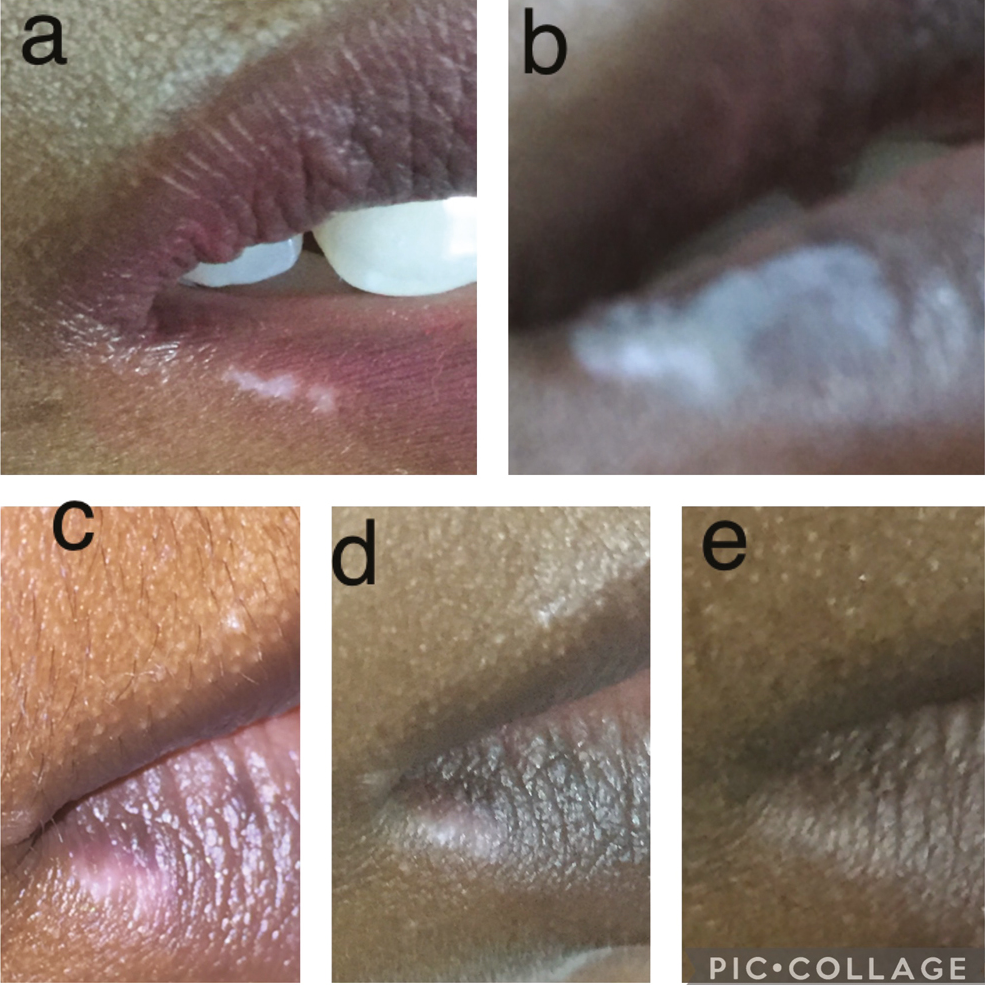Translate this page into:
Trichloroacetic Acid Cautery for Repigmenting Nonresponsive Vitiligo on Lips
Address for correspondence: Dr. Muhammed Mukhtar, Department of Dermatology, Mukhtar Skin Centre, Katihar Medical College Road, Katihar 854105, Bihar, India. E-mail: drmmukhtar20@gmail.com
This article was originally published by Wolters Kluwer - Medknow and was migrated to Scientific Scholar after the change of Publisher.
Dear Editor,
Vitiligo that involves the angles of the mouth and lips is a cosmetically stigmatizing condition.[1] This site presents a therapeutic challenge because of its high mobility, mucosal surface, and variable response to therapy. Surgical methods including suction blister grafting, miniature punch grafting, and split-thickness grafting have been tried with successful results.[2] However, these processes are time-consuming, require technical expertise, have considerable downtime, and cost limitations. Microdermabrasion, fractional CO2 lasers, and microneedling as well as topical 5-fluorouracil have been used successfully in stable vitiligo on other parts of the body.[345] These combinations are simple and easy out patient department procedures. Trichloroacetic acid (TCA) cautery is a well-known method of treatment that has been tried on other parts of the body.[678] Here, we have used TCA to reconstruct a vitiligo lesion involving the lip in an adult female [Figure 1A].

- (A) A lesion of vitiligo on lip before TCA cautery. (B) The lesion of the vitiligo after the cautery. (C) The lesion after 2 weeks of cautery. (D) The lesion after 4 weeks of cautery. (E) The lesion after 6 weeks of cautery
Under aseptic precaution, vitiligo patches are cauterized superficially with TCA (100%) for 1–2 min till frosting the lesions. After that, topical antibiotics and moisturizers were applied to the cauterized area for better control on infection and proper moistures at the site, and it was recommended to apply them 4–5 times per day for 2–4 weeks to allow the site to heal quickly and properly. Erythema, erosion, and crusting were observed in the first week. Reepithelialization and partial peripheral hyperpigmentation were evident by the second week [Figure 1C], and then, the site was exposed to sunlight without psoralen for 15–30 min daily after 2 weeks of cautery to enhance the repigmentation process. Satisfactory pigmentation was observed at the end of 4 weeks [Figure 1D], which fully pigmented after 6 weeks [Figure 1E]. Therefore, chemical cautery with exposure to sunlight is an economical and simple method of treating the small lesions of vitiligo. However, a well-controlled randomized trial is needed to justify this technique.
Financial support and sponsorship
Nil.
Conflicts of interest
There are no conflicts of interest.
REFERENCES
- Re-pigmentation of vitiligo involving angle of lip using radiofrequency and 5-fluorouracil. J Cutan Aesthet Surg. 2021;14:456-7.
- [Google Scholar]
- Suction blister epidermal grafting for vitiligo involving angles of lip: Experience of 112 patients. J Cutan Aesthet Surg. 2018;11:13-9.
- [Google Scholar]
- Vitiligo effectively treated with electrocautery needling technique. Dermatol Ther. 2020;33:e14154.
- [Google Scholar]
- Microneedling combined with pimecrolimus. 5-flurouracil, and trichloroacetic acid in the treatment of vitiligo. A comparative study. Dermatol Ther. 2022;35:e15294.
- [Google Scholar]
- Clinical evaluation of the efficacy of trichloroacetic acid 70% after microneedling vs intradermal injection of 5-fluorouracil in the treatment of nonsegmental vitiligo; a prospective comparative study. Dermatol Ther. 2020;33:e13532.
- [Google Scholar]
- Effect of different types of therapeutic trauma on vitiligo lesions. Dermatol Ther. 2017;30:e12447.
- [Google Scholar]
- Trichloroacetic acid in different concentrations: A promising treatment modality for vitiligo. Dermatol Surg. 2021;47:e53-7.
- [Google Scholar]





